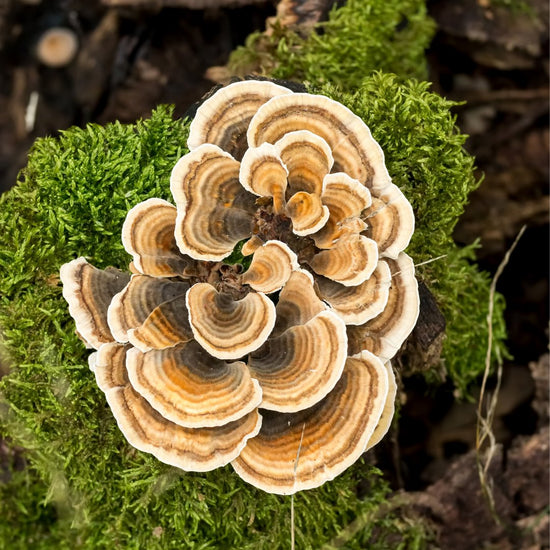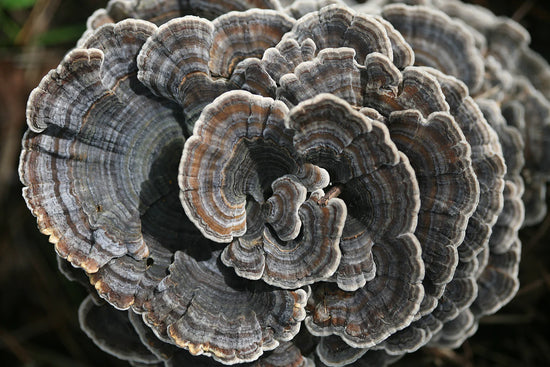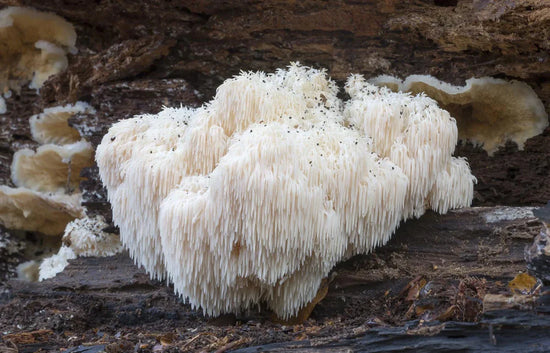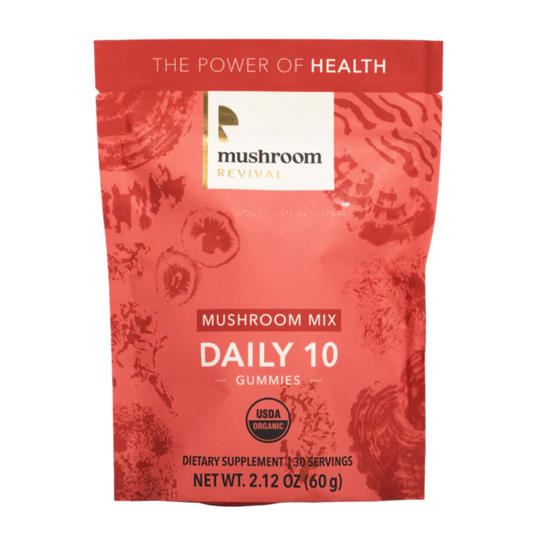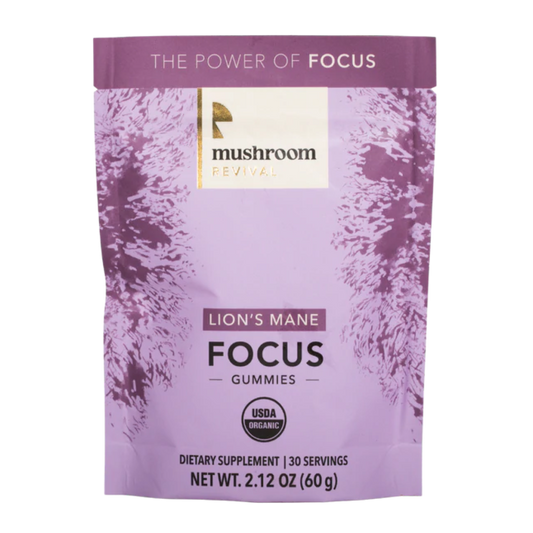Fire Loving Fungi
Alex Dorr
">
.js?container_id=buzzsprout-player-&player=small"
type="text/javascript"
charset="utf-8">
Burn sites create unlikely food for today’s fungal topic: pyrophilous— or fire-loving, fungi. Today on the show we welcome Dr. Monika Fischer, who has been studying fungi that thrive in post-fire ecosystems. We discuss how wildfires change ecosystems, the roles that fungi play in their recovery and protection, and how scientists go about studying them.
Topics Covered:
- What makes a fungus a fire-adapted species?
- Current state of wildfire events
- Organisms and ecosystems that rely on fire
- Variations in wildfires and how various fungi respond
- Mycological properties of fire-adapted fungi
- How fire-loving fungi are germinated and cultivated in the lab
- Mycoremediation and fungal enzymology of fire-adapted fungi
Show Notes:
- Dr. Monika Fischer Website: https://sites.google.com/view/monikafischer/home
- Dr. Monika Fischer Twitter: https://twitter.com/MonikaSFischer
- NY Times “This Fire-Loving Fungi Eats Charcoal”: https://www.nytimes.com/2021/11/28/science/fungus-wildfire-charcoal.html
- Publications: https://scholar.google.com/citations?hl=en&user=RDJjNPAAAAAJ&view_op=list_works&sortby=pubdate
TRANSCRIPT
Alex 0:01
You're listening to the mushroom revival podcast. What's going on guys? Some of you may have noticed that we been not posting as regularly as we used to. We used to publish an episode every week on the week. And the last few weeks, we've been kind of doing it every other week. So we've been incredibly busy. Life is sometimes a little chaotic, but we've been trying our hardest to get these episodes out so your hungry ears can devour this fungal information. So thanks for being patient. I know you've been I know we've been getting messages and people like where's it next episode. So, thank you for being patient, we got you. We will continue these episodes come in on a cadence. So we are talking about fire and fungi today. This was such an enlightening conversation really shifted my perspective on fungal diversity and fungal ecology and forest fires as a whole. If you want to support the show, and you love what you're listening to. We don't take any third party ads, we don't have a Patreon, we don't have a way for people to donate to support the show. We've put in a lot of Blitz, blood, sweat and tears and time and energy into making this content for y'all. So how you can do it is just word of mouth is his number one, telling all your friends and family to tune in, to leave a review and to share on your social media. And speaking of reviews, we actually pick one review a week to show off to the rest of the world, your fungal love that you're sharing with us. And actually the the review of the week is from Lee Corvis. And the subject is best fungal podcasts the subject is being a sub a student and lover of everything fungus. This podcast and its hosts bring incredibly valuable information, perspectives and insights into the ever growing field of mycology. Bringing together specialists from all across the field to discuss, learn and teach about their nuanced professions. With unfaltering passion these two in more ways than just their podcast has helped me better understand complex fungal relationships, expanding my own mycelial network as well as providing inspiration and guidance in my own mycological endeavors. Without a doubt, the best fungal podcast there is. Thank you a an L that was amazing. You know, sometimes you get really short reviews, sometimes it's a long, beautiful poem like that. That was but if you want to be featured, leave your best review and you might get lucky and we'll feature you on the show. Another way to support we have a website mushroom revival calm we have a whole line of functional mushroom products from tinctures to capsules, to powders gummies coming super soon, they might be out when when this episode is released. And if you want to use a discount code, it is pod treat. Just enter that thing at discount for a surprise discount. We won't tell you what it is. We change it all the time. So just plug in the code pod treat at checkout to get some fungal goodies. All right, the moment you've been all waiting for let's get into the show. I love this one. This is your you're gonna love it too. Talking about fungi and fire.
Lera 4:05
Welcome Monica Fisher, I found you via the New York Times article about fire loving fungi. And, you know, I didn't know that there was a researcher out there with such specificity to their psychological niche. And I love it. I love that you're here. Thanks for joining us.
Monika 4:20
Yeah, it's great to be here. Thanks for inviting me.
Lera 4:22
So would you like to tell us about this psychological niche and how you ended up here? I mean, did you have a love for fungi? Was it ecology? And then how did you get in touch with the New York Times? How'd they find you?
Monika 4:37
Oh, yeah, these are these are all good questions. Yes, obsessed in love with mycology and ecology broadly, there's I feel like there's sort of two avenues to being a scientist. One is your study organism and one is your question. And ideally, you're asking the best questions for you Your organism or your system, or like your your system, or organism is well suited to the questions that you're asking. I feel like I'm probably not alone in saying this, that fungi are a deal breaker for me. mycologist tend to be a little we're obsessed with fungi. But we also find questions that are well suited to, to being able to answer them in fungi and be able to understand how fungi are working both internally within the fungus and then how the fungus is, is interacting in its world with other organisms. And that's ecology. So how did I get excited about postfire? fungi? Let's see, I guess. So my projects, specifically started back in 2013. Before I was ever on this project, it was a second year grad student at Berkeley in Louise glasses lab working on fungal genetics and molecular biology, nothing to do with fire. But one of our close colleagues down the hall, Professor Tom Bruns, he's a classical ecologist. And he was part of a long term monitoring project where they're just monitoring fungal diversity. Over time, over some huge geographic area, it might have been national, it might have been global, I don't remember that detail. But he had two sites that are right outside of Yosemite, where they just go every couple of years just to see who's there to keep adding to this long term monitoring data set. And in 2013, the rim fire burned through those plots, which is like any colleges dream, that's a natural experimental treatment, or like a mother nature created an experiment for us. Yeah, which is super, he got super lucky. So he has all of this data from before the fire now all they have to do is go sample the exact same sites post fire, and they have this beautiful comparison of this is what this exact same piece of earth what the fungal community looks like pre fire and post fire. And then they were able to track it for about a year and a half afterwards to see how the fungal community shifted over time. And so the way that they're doing this was by collecting soil and just sequencing all the DNA in the soil. And then they were also collecting any fruiting bodies that they saw coming up and bringing those back into the lab, identifying them, getting them into pure culture, and sending those off for genome sequencing. And so now we have this whole culture collection of living organisms in the lab that we also have reference genomes for, that we can use to study how these organisms really do, what they're doing in the lab. And so that's really where that was about where Tom's research stopped, and I picked up the torch and ran with it. Tom has Tom Burns has since retired. But he's still around.
Alex 8:13
It is really funny how, you know, the general feeling that I've heard for most people with wildfires, or forest fires, it's, it's, it's sad for most people and shocking and a lot of negative feelings. But for you, it's excitement. And like, oh, wow, this the this is when the organisms that I study come out, you know, and they thrive. And it's just, it's really funny when you're studying biology or ecology on these mass timescales of once you kind of dissolve the human perspective or ego. You know, it things Yeah, good and bad just kind of falls away. And it is beautiful to like, hear you getting really excited about these forest fires, right? During a time of like, Go Global Weirding where I know so many people that live in California and you know, Oregon, and you know, are just like oh, it's the worst like I have to move away and and here you are like, Yes, this is great for my research, you know, and that's super cool. It's it's cool to, to hear different perspectives, and I'm just curious, like on the the fungi eyes point of view, are you do you feel like they're adapting? Or do you feel like they're thriving? Hmm.
Monika 9:40
I think they've already adapted and yes, they're thriving. But I just want to take a minute and like sort of appreciate emphasize the darkness that you just brought up that I I feel like I've had to learn to kind of check myself Because, yes, wildfire is a very real thing that happens that direct that directly impacts a lot of people's lives. It, there is a very dark, heartbreaking side to fire. And to some extent I feel like this this is this is just ecology like, ecology is messy. I agree with you that there is no good and bad, but there's so much heartache that can be associated with wildfire that is very real. And I do like to acknowledge that and say like, Yes, I am bringing up a potentially traumatic topic that like I know, people who have been really severely affected by Wildfire. And it's really hard for them to understand how anyone could possibly get excited by anything related to wildfire, because it can be such a traumatic experience.
Alex 10:55
Yeah, I mean, this kind of the lesson, why I love fungi so much is it takes a lot of this darkness and creates new life, right? I mean, it's like, we don't like to talk about death and decay. And, you know, but it's out of composts that new life flourishes right out of the death of a wildfire like these new fire adopted fungi are thriving, you know, and that's super cool to talk about the full yin yang aspects of life, where it is a an ecosystem, and there's organisms that thrive in every single environment, you know, and like, where death happens, life emerges. And I feel like the conversation around fire has just been mainly focused on the death part, right, or that the quote unquote bad part, but it's great to have this conversation to focus on. Okay, what what, quote, unquote, good is coming out of this? And, you know, there are actually organisms that frickin love it. Yeah. And they're, like, are waiting for that fire, right seeds. And these fungi are like waiting for those high temperatures to emerge and thrive. So, yeah, I'm excited about this conversation. Yeah,
Monika 12:09
totally. And a lot of a lot of organisms needed. Like, there's there's a lot of research on how several plant species really need fire to keep their plant communities healthy and vibrant. And, and I don't know, quote, unquote, like tidy, and for their seeds to germinate. And we're starting to learn that some fungi have a very, very similar adaptations.
Alex 12:33
Maybe you don't have the, the the answer, but I've heard from a lot of forest ecologist specialists that, that, you know, forest fires are good is just the frequency of them. And right now, you know, we're having infrequent major fires. And that's when it's more problematic to more ecosystems and structures that humans create is when the fires are very infrequent. But when they happen, they're huge. Rather than more frequent, smaller fires. Do you have any data to attack on the effects of, you know, to fungi on less frequent bigger fires, as opposed to more frequent smaller fires?
Monika 13:23
Oh, yeah. So this was one of the big questions that really irks me really early on when I first started working on this, and pretty much the only data we had was from the rim fire. And I was initially starting to take all of those isolates that we had in the lab, and I was gonna study them in the lab, but I was like, Oh, how representative is this of fire in general, like the fungi have different responses to different fire intensity, different plant ecosystems? Like basically, was the rimfire a fluke or not? And when I started on this line of research in 2018, I did like dive into the literature and I was cruising around on a naturalist and like googling every corner of the internet trying to find what people knew about postfire fungi. And there wasn't much which was really surprising to me. And I actually wonder if some of that is because people just sort of had this perception of everything dying. And there's like, why go look because we know there's nothing there a fire just obliterated everything. But also like fires have been fewer and far between and kind of deep in the back country. And it can be really logistically complicated and dangerous to go out to recently burned areas. But 2020 happens. Many things happen in 2020, but we had that. Totally bananas lightning storm. So you guys are not in California right now
Alex 15:03
we're in Austin, Texas. Awesome.
Monika 15:05
Okay, so I don't know if if you heard about this, I think anybody living in California will remember this forever. We had, so we don't normally really get any lightning here. But we had this wild, dry lightnings store. All across northern California in the driest month of the year, it ignited a mind boggling number of fires. A lot of fires very close to the Bay Area. Which speaking of heartbreak, literal lung ache, from inhaling smoke, like, while the fires were burning, it was it was pretty traumatic, it was really rough. But then once the rain came basically as soon as the rain came, and CalFire declared that some of the burned areas were safe to go into. There were a whole bunch of different fires very close to where I lived. And so it was really easy for me to go out about once a month every month, we were already involved in some prescribed burns, which are like intentional, controlled low intensity burns up in the Sierra Sierra Nevada, near Lake Tahoe, which is very similar ecosystem to where the rim fire happened. So we had a controlled burn that we had done in 2020. We I had several wildfires that happened very close to where I lived also in 2020. And so I just started going out about once a month every month to go see what was happening in all of these different ecosystems that experienced very different levels of fire. I just said this, but yeah, they're very different ecosystems. One site that I was visiting is sort of a coastal oak forest. Also lots of Bay Laurel, the California bay leaves are tasty and soup. And then there's our like, classic lush redwood forests. Just east of here is a lot of cattle range land, that's mostly grass and some very scattered oak trees, like it's very hot and dry most of the year. And, and then a prescribed burn in like a classic Sierra Nevada mountain pine forest. That was a much lower intensity burn. But in all of those areas, I saw the same fungi coming up. And they're just like, so bright and colorful and cheerful and coming up all over the place at the same times, too. I think it has more to do with the rain. Like when precipitation started as soon as there's enough moisture for them to grow. They do it they go for it. But it was really incredible to see the same fungi coming up after different intensities of fires and very different ecosystems. So yeah,
Alex 17:59
interesting. Yeah, I've only heard of morels. And that's that's been a thing since I first started getting into mushrooms have a look. And in a place that just had a fire like the previous year, if you're looking for morels, and actually the first morale I've ever found. I was on the border of, of Nevada by Lake Tahoe. And I was searching and it was like way past season and everyone who knew Morales was like, Yeah, you're you're about a month late, you're not going to find any, you know, and I was I was determined. And I would go out every day for weeks. And I would try to keep going higher and higher elevation, different ecosystems, whatever wasn't finding anything. The last day, I went to a burn site, and I'm looking around the sun is starting to set I'm like, Okay, I'm never going to find it. I give up. There's a renaissance fair right across the road from this burn site. Like okay, I'll all sneak into this renaissance fair because it just had a major fence around it and no one was paying attention. So I hopped the fence and a land from hopping the fence right on a morale and it was just a single morale. No, like right in between my feet. I didn't step on it. And and that was just the one morale I've I found and right next to a burn site, so yeah, I'm curious besides morels, what other mushrooms were you finding or what other fungi? Yeah,
Monika 19:33
so many adorable little pink and orange cups.
Alex 19:36
Nice.
Monika 19:39
Yeah, it's interesting that the the sort of series of fungi that tend to come up after fires it, it almost follows the phylogenetic tree. So it starts out with these like really small, little orange and pink and sometimes brown cups. There's also a purple PISA that I have was new new to me last year because that was a violation or Josefa Felicia might be called. Yeah, there's so much color and I feel like it it sort of echoes the color of fire in this really wonderful way. We have these like orange and pink and red and purple cups. And yeah, so that's para NEMA anther cobia answer cobia is a prolific fruiter if you go out to a an area, right after it's burned, before morels come up, you'll likely see these like carpets of ants or cobia that are just it's like a orange 70s shag rug almost, except they're like little tiny cups. It's not hairy. Wow. Yeah. And yeah, then a little bit later you start getting morels which are also an ESCO my seat so if you think about all the little pits in the quote unquote cap of a morel, you can think of like each one of those like a cup. And so it's just like lots of little cups stuck together. So all ascomycete fruiting bodies are just a modified cup. Yeah, so you have your your sort of like bowl shaped cups, then you get your morels and then a little bit later you start getting basidiomycetes like lay off lum Cressy Spore, again, there's a fully OTA that's fire associated?
Lera 21:31
Do you know what? Like? Do you have any data on why these things are fruiting in the order that they are?
Monika 21:39
Yeah, that's one of the questions and trying to answer now. And that's a great question. I think so some of it might just be growth rates that Purnima and answer cobia grow really fast. And so that's part of how they get there first, whereas the city of my seeds grow slower. And so that's why we see them later. But there might be some sort of dynamic going on, where like pirate NEMA might be breaking down some nutrient source that a later fungus needs to eat the breakdown product from pirate Nemo, or maybe anther cobia is producing a bunch of stuff that sort of inhibiting the growth of other fungi. And they have to overcome that or Yeah, it could be any number of things. We're actually in the middle of a giant experiment in the lab right now with all of those isolates from the rimfire, basically testing, like all possible combinations of growing them in in a sort of simulated succession on a charcoal medium. Oh, wow. Nice.
Lera 22:46
That's so cool. Yeah, so
Monika 22:48
stay tuned. That'll be hopefully paper coming out.
Alex 22:53
Cool. Well, I don't know if, if you're far enough along yet, but my thought process coming from studying Mike remediation for so many years was just like, the amount of enzymes that they're producing, is probably wildly different from in other environments. I'm guessing this is chock full of polycyclic, aromatic hydrocarbons from like half combusted, you know, carbon, so I'm sure it's like, really toxic for most organisms. But as we know, fungi are just really adaptable. And resilient. So I'm just curious if you know anything about like, are they expressing new enzymes that we haven't seen them express yet? Are they and that was kind of my first question. Are they thriving? Like, do they? Do they grow faster in this environment, compared to a non burn? Or are they just kind of like, oh, I don't have much competition? I'll I'll grow here. Just because I'm an organism and I want to survive. Does that make sense? Yeah, I mean, I
Monika 24:00
think I would say they're thriving, given the circumstances. Like they're, they're thriving, because nothing else is able to thrive in that environment. But if you give them like a buffet of sucrose, and everything they could possibly want.
Alex 24:20
Yeah, they'll pick that. Yeah. over charcoal. Exactly.
Monika 24:26
And I think that's some of what makes these fungi really cool is that they are sort of able to use whatever is available and like make do, do you
Lera 24:37
know if they can use charcoal solely as a medium to grow?
Monika 24:42
Yeah, so that's the paper that got picked up by the New York Times was all about how Purnima is able to grow on pure charcoal and essentially nothing else. Wow, that's crazy. Yeah, so we initially did Did an RNA Seq experiment to see which genes were being turned on in response to growing on charcoal? And we, to get back to your question about enzymes, we did find this whole suite of cytochrome P 450s. Which are usually involved in that like initial attack of an aromatic compounds that's like, really strong ring structure. That's it's a takes a lot of chemical energy to break that bond. So organisms tend to not like to do that. But Pyron. Ema has several genes that can do that. It also really strongly turned on all the genes that would need to incorporate aromatic compounds back into central metabolism. And then we also did a stable isotope experiment to show that it is actually converting stable isotope tagged charcoal into co2.
Lera 25:54
So does this fungus have genes that most other fungi don't? Is that kind of what what you're seeing with its opportunistic properties? Or like, what else might be going on here?
Monika 26:07
Yeah, that is a great question. The, we have a little bit of, well, okay, actually, we have a ton of data. Because we have genomes for all of these organisms. And for all the fungi that Tom's lab collected after the rimfire, we also have genomes for other fungi. And so some of our collaborators at the Joint Genome Institute, which is associated with Berkeley, it's part of the Lawrence Berkeley National Labs. are collaborators collaborators there are doing a big comparative genomic study to answer that question, and I don't have a clear answer for you right now, I'm, my feeling is that they don't have different enzymes, there isn't like some, I think it'd be highly unlikely if we're going to discover some novel enzyme that nobody's ever heard of before. But it might just be that they have more of them. Or maybe they have a couple enzymes that that are very similar to enzymes that we already know a lot about, like the cytochrome P 450s. But it might just, it might be using it to attack a different compound or something.
Alex 27:28
And we were just talking about how some plants their seeds need actually need fire, indirectly or directly to germinate, which is insane and crazy and a great backup plan. When fires do happen, have you tried to test of trying to light the spores on fire or something like that to see if they germinate?
Monika 27:54
Oh, yeah, no, totally. This is so actually the fungus that I did my PhD on Neurospora crassa. That's like, it's like the lab rat of fungi. It's you. It's used as a genetic and molecular model, but it's actually a postfire fungus. And the way that we germinate its spores in lab is either by heating them to 65 degrees C, which I think is about 150 Fahrenheit. Or you can just play them with a little bit of liquid smoke like that. You Wow, that's,
Alex 28:22
yeah, trick. Wait.
Lera 28:24
So it's not the heat.
Monika 28:26
It's either liquid smoke. Like if you go to the grocery store, and you want to make a really cheap and quick barbecue sauce and you buy the liquid smoke.
Lera 28:35
That's so weird prompts termination of knaresborough. Yes. But there's no temperature fluctuation. So what's what's happening? This is so interesting. pH
Alex 28:45
is are triggering it. Yeah, that's,
Monika 28:50
this is a great question. I would love to know this is on my long list of, of scientific mysteries. I would love to be able to answer in the course of my career. To figure
Alex 28:59
it out. You're you're coming on for for an update.
Monika 29:03
Yeah. And it's interesting that the heat alone will do it too. So we don't know if that's two different mechanisms like it will. It'll respond to heat or a chemical input or is something about the heat triggering a chemical transformation in the spore coat? And that's the same chemical that's in liquid smoke. I don't know.
Lera 29:25
So do you make like liquid smoke Agha?
Monika 29:30
No, you just pour a little liquid smoke. We actually pour it in the lid of the agar plate. So it's sort of like, aerosolized is in the plate with the spores.
Lera 29:42
Wow. I love it. I love whoever it was just like you know, I'm gonna go to the grocery store, buy some of this liquid smoke. Try it.
Alex 29:50
And I'm guessing you've tried this with other species and they haven't worked. And then for whatever reason, just this handful of you know Was it precisa? Se pronounce it?
Monika 30:04
The No, the one that terminates the spores germinate in response to smoke.
Alex 30:10
That one or just all the all the species that you found and worked with? I'm guessing, obviously because a certain amount thrives in this environment and other species that are normally growing in this environment don't. Any ideas why or is this? Also the big mystery?
Monika 30:33
Yeah, that's a great question is I'm okay, so there's this big question in ecology of like, is everything everywhere? Or is is there biogeography? And I think it depends on the organisms. I mean, I think it's every Everything can't be everywhere. That just seems a little silly to me. But it is really interesting how these same fungi at least pirate NEMA, for sure seems to really perineum and answer cobia actually come in Neurospora come up after five fires in very different ecosystems all over the world. And so they might just be waiting for a fire to come in and kill off everything else that can't survive. And then it's really good at taking over for a very short period of time, right after the fire.
Lera 31:31
Yeah, I was nodding. Do you ever see these species fruit in environments where there has been no evidence of a fire in many, many years?
Monika 31:41
So I guess this this also gets at, what does it mean to be pyrolysis? And so I like to think of sort of a gradient perhaps, where there's like truly pyrolysis things that we never see outside of a fire. And that's like Pyro, nema anther cobia, some species of Neurospora. So there are some species of Neurospora. That will, it's a bread mold. Also. Sometimes you can find it on coffee grounds and your compost. Or maybe that's just me.
Yeah, and then, right. So there's also morels, some species of morels that are only associated with fire, but there's more cello, reefer bernia, that will grow on wood chips, regardless of a fire. It's not as delicious, but and then there are fire tolerant things. So things that you might see coming up after a fire, that are mixed in with all of what I would say, are truly pyrolysis fungi. But they're just sort of they were just fire tolerant enough, or maybe they were deep enough in the soil or something happened, they were able to get by and survived the fire that time. Or maybe, maybe they're always fire tolerant, but then they don't really survive well in post fire environments, or you see them consistently outside of post fire environments. They might be really truly generalists. That'll live really anywhere. So yeah, like scuttle linea there's actually super NEMA tacy is the family that pony Mina and answer Kobe are in and there's a couple other genera, like scuttle any is the classic eyelash cup that has really long hairs. That one could be considered a fire tolerance, one that might come up in some areas after fire, but it also comes up everywhere without fire.
Lera 33:45
So I'm curious about what a forest how it would recover from this if these fungi weren't present. And maybe there's never been a case of this probably have to be a really epic fire to like completely wipe them out. But do you think that these fungi are helping the recovery by breaking down these pH heavy materials to open it back up to other microbes and things? And how much of that is being facilitated by fungi?
Monika 34:17
Yeah, I think fungi. This is my personal feeling is that fungi play an important role in these really early postfire ecosystems to sort of liberate a lot of nutrients from this pile of charcoal and ash that's otherwise very inhospitable to organisms that are going to come later and fungi can help sort of make it more hospitable to more organisms. And my favorite hypothesis for what pirate NEMA is doing because it grows really quickly. It's in super high abundance immediately after the fire was shown it can break down paralysed organic material, there's like really complicated pH structures that are really prevalent in post fire soil. But then it disappears really quickly. And so I love the hypothesis that Pyro aneema is basically like gifting it's by its body, it's biomass to the organisms that come after it. And it, it grows really quickly, it creates a lot of itself, and then it dies. But all of that biomass that's left, it's its body, essentially, is really easy food for any organism that's gonna come after it. And so that can help. That's actually two, there are two things that I think are interesting about that one, it can help feed the next iteration of organisms and two, it might help with erosion. Because if you think of the mycelial network, it's it can help serve to keep the soil aggregates in place. I mean, assuming the rain isn't like, too torrential or anything, there was a paper that came out recently showing that I think it was parenting that does, like help aggregate soil. So
Alex 36:14
cool. It has me thinking because when I was studying micro mediation, one of the ways in which large scale industrial projects, they'll immobilize enzymes, which, you know, for listeners who don't know what that means, the enzymes are basically the stomach juices that fungi excrete out to break down toxic things. And, but they're really susceptible to pH changes or temperature changes. So they'll break down and become basically inactive. So you need to immobilize it. So protect them from those temperature, pH, etc, changes. And one of one of the methods is in carbon nanotubes. Now, charcoal is not that, but it's somewhat close. It's not on the nano scale, but there are, you know, a lot of small tubes in there and it's carbon based. And so for a while, I was like, yeah, that's kind of like a myco biochar you know, and yeah, one could potentially use, you know, charcoal with fungal enzymes in it as a great kind of more grassroots way to remediate a site. And this is seeming like it's already happening. You know, in these fire postfire situations, and it seems like these fungi are, are kind of using charcoal as a home base, and maybe even helping drill more holes in the, the charcoal, so more bacteria can go in there and, and really create, you know, the foundations of a cleanup and create more life. So yeah, this is super cool. I, I'm interested in what's going on inside the, the bits of charcoal and I don't know, if you have any studies or future plans to kind of investigate what's what's going on the inside?
Monika 38:19
Oh, yeah. That's a great question. I yeah, this is in my list of future plans. And yeah, I absolutely thought that there could be some cool, they were mediation applications for this. Because a lot of the quote unquote toxic compounds that are the focus of bio remediation projects are also present in charcoal. But we think of charcoal as this natural, right thing that in some cases is actually a good thing, because it can function as a carbon sink, because it does persist in the environment for a long time. But some of it is obviously breaking down. And yeah, I would love to find out what the bio remediation application of this research is gonna be. I feel like there is one but we're, we're a bit of a ways off from it at the moment.
Alex 39:20
I mean, but it's cool that, you know, humans like to get involved. But usually, everything is better when we don't. And it seems like it's already just fixing itself, right? And it's already like, the systems are already in place. And humans don't actually need to do anything. Which is the cool part, which is awesome. And you know, it just puts it in perspective. And this is going back to kind of what I was asking one of the first questions is like the infrequent vers frequent fires, it's like, it seems like in terms of fire ecology, everything is better in humans. Just Got to get out of the way. You know, and we tend to just mess everything up. So, yeah, what what impresses you the most, I'm sure you've spent many nights awake with your mind turning of all these different questions, and you've gone through all the rabbit holes of what fire fungi can do. What has been the most impressive aspect of fire fungi for you?
Monika 40:27
Huh? Right. The most impressive thing is just how vibrant and like how many there are, I was shocked at how much life I found, basically, immediately after wildfires and also a prescribed burn. And they're just like bright and cheery and colorful, too. And I'm a bit of a visual person. I really like the colors of postfire fungi. And yeah, just how many there are how well they're doing. There's so much life in postfire ecosystems, like very recently burns, postfire ecosystems, and just really want to communicate the beauty and the tenacity and the resilience in postfire ecosystems, especially in the fungi that are often coming up before plants even come up. And they're just loving life in this landscape that we as humans have sort of marked as this destroyed. heartbreak, heartbreaking place, but there's so much beauty and life there, too. So yeah, the yin and yang, as we said earlier,
Lera 41:40
like the first day of their new life post fire. And that's it's a birth in many ways.
Alex 41:47
Yeah, I've had many visions, on psychedelics of just kind of the world crashing and burning and all this stuff. And it's very heartbreaking. And then the light at the end of the tunnel was like, Yeah, fungi will love it. They'll be there. Well, we'll nuke each other, we'll do all this stuff. And they'll be at the end of the tunnel, just like y'all eat all that radioactive waste, and all that stuff you leave behind, like, everything will be fine for fungi, they'll, they'll stick around, and they'll eat up all our our dirty room when we leave.
Monika 42:17
Yeah, I prefer to not leave a mess for them. But as long as the fungi when I'm happy.
Lera 42:26
So this has been so interesting. And I know that you have 1,000,001 questions in your department. But what do you think in the fields is one of the more pressing questions? And what do you hope to see? Maybe in this fire adapting fungi but also in mycology? In general?
Monika 42:45
Yeah, I think getting at mechanisms of how are these organisms doing what they do? This is sort of the the trajectory of microbial ecology in general, like a lot of microbial ecology began as who is where, and now we're, we knew a lot about who is where, although we're kind of really just beginning to understand who is where in postfire environments. But then the next question is, what are they doing? And how are they doing it, which you really need, you need tools in order to do that you need a manipulatable system. In order to do that, and ecology that can be really difficult. And so I feel like we've gotten really lucky in that we have this isolate collection that we can manipulate in the lab. When Tom Bruns actually also developed this method called a pirate chasms we can make like little mini forest fires in a bucket just outside of the lab Yeah. So that we can really manipulate what is going on with the fire what is going on with the organisms What if we have each organism by itself? What if we put all the organisms together and like what if we feed it different things? What if we feed it specific pH is what if we feed it charcoal at different temperatures? And then we can look at gene expression and we have an LC MS in our labs we can start to get at the chemistry of of what exactly is the chemical composition of charcoal and how is it being broken down what what is the the compounds that are resulting from that? So I mean, that's like that is a lot of open questions. But I think that's that's absolutely where we're all going is trying to understand the the how, how these organisms are doing what they're doing.
Alex 44:45
I'm sure it hasn't been an easy process, where every single door just opens and you can walk right through and sure it's been twisty turny, and I don't know maybe your whole life got contaminated or Yeah, you got lab results that messed with two years of research or whatever. But what what has been kind of the hardest moment in your research? Hmm. It's everything. You're waiting for that light at the end of the tunnel.
Monika 45:15
Honestly, like this has been such a, like a positive, awesome scientific journey for me. Oh, yeah, I think partially because like, I guess part of what has been scary to some extent is realizing how little research there was to stand on like there was not much that was really known about postfire fungi or even like Neurospora is the most well studied filamentous fungus, but nobody has studied it in its ecological context. Like we we all use smoke and heat to germinate the spores, but nobody knows what that mechanism is. Yeah, I think it's totally crazy, too. But I'm hoping that I can start to answer some of those questions. One day.
Alex 46:11
Well, since it's all been good and fun journey. Let's go on the other side. And has there been one moment that has been the most exciting or like a champagne popping day where you know, you wanted an award, or you finally got the results in or something like that. That's been the most exciting, huh?
Monika 46:33
This perineum of paper was surprising and exciting. And it was it started out as sort of a side project. And then it became a like, well, I have nothing better to do with a pandemic project. And it just like, we didn't really set out to do what we ended up doing. And it ended up being surprisingly easy and straightforward, which I feel like never happens. I had a rotation student Grace Stark, which, when you're a first year PhD student here, you spent 10 weeks in three different labs to sort of like sample a couple different labs before you decide what's going to be your lab home for the next five years. And so Grace was doing a rotation in our lab with me on this project. And I sort of threw a whole bunch of stuff at her as like, let's do an RNA Seq experiment, like, let's just see what what perineum was doing on char and then, you know, this might be part of something bigger later, I thought that I was gonna scale it up with like, all together postfire fungi, it was gonna turn into this, like epic paper with RNA seek from multiple organisms. But then we got the RNA seek results back in, I think, at the beginning of March 2020. And then we went into lockdown, mid March 2020. And I had this giant data set is like, Well, might as well start analyzing it. And so Grace and I analyzed it together while we were in lockdown, and then we're still in lockdown. We're like, well, I guess we should start writings since we can't go into the lab. This was also when I was running around to all the, the burn sites nearby, which was really cool. And yeah, it was like a really straightforward paper to write of like, Oh, hey, look, all of the like, it was really obvious that paradigma was strongly turning on all of these genes that you would need to degrade poly aromatic hydrocarbon compounds. Which I feel like that doesn't always that doesn't always happen. With RNA seek data, sometimes you have to really filter things and apply some statistics to it and sort of like massage out what the strong trends are. But it was the data were just really obvious. And then we shared it with our collaborators. And they're like, oh, we have a whole stable ice ice, excuse me, a whole stable isotope set up the that we can use to like more directly test this because RNA seek is just telling you that the genes are expressed but are so that the genes are being transcribed. But is that RNA actually being translated into a protein? Are those proteins functional? Are they are they catalyzing the reactions that you expect them to catalyze? There's a lot of questions that RNA seek does not answer that stable isotopes could. And so we sent Poornima over to our collaborators in Wisconsin and Thea Whitman's lab and her grad student nail Zebah and our postdoc Tim Berry, ran this whole experiment to grow Pyro NEMA on The C 13 labeled charcoal and then collected co2 And it was just like, yeah, there is C 13 labeled co2. Bam. That's it done. Yeah. So satisfying very, it was just, I guess it was elegant.
Alex 50:20
So, last question. And I get really excited on these types of episodes where the topic is around mycology. But it's a specific niche that like, no one is studying, but is unbelievably important, and can potentially have huge impacts on the world, and it, it seems to be something that everyone kind of interacts with, but no one is talking about it. Right, like, everyone is talking about wildfires. And mushrooms are becoming a thing, I guess, in my worldview, but maybe maybe not in, in other people's but I'm sure we have so many people listening that are from California, or, you know, Oregon has have personally dealt with wildfires and are obviously, because they're listening to this interested in fungi. And I'm sure there's another group of people that fit that description and are looking to kind of make a career in mycology and maybe are looking to go to school and looking for Okay, what do I want to study with mycology? And and potentially this episode is going to be inspiring for a few people on to change their their path. So what piece of advice would you give those people that you wish someone told you when you were first starting out?
Monika 51:47
I love that. I feel like somebody may have told me this. But maybe not. This is definitely just in my nature, is to talk to everyone. Like go find people doing the things that you're excited about the things that you think you might want to do. And just talk to them get a sense for what their life is like and what what what are they actually doing. And like, feel free to reach out to me, you can shoot me an email or message me on Twitter. If you're listening to this and excited about what I'm doing. I'm always happy to chat with people that are excited about this stuff and thinking about heading in an academic roots or mycology roots. It's yeah, it's really hard to know what you want to do unless you sort of try it on a little bit. Or like get get a sort of firsthand sense for what what is that type of life going to be like for you. Like get involved in your local Mycological Society, email professors or grad students that you're excited about their work at your local universities, see if you can see if there's like any opportunity for you to get into their lab, like just reach out to people and see, see what happens. You might be surprised.
Lera 53:08
Absolutely. Couldn't agree more. Well, I'll have links to all of that in the show notes for anybody who's interested and on how to follow your amazing work. You're really original work and all the press that's been featured, and anything else that's that's awesome. Any papers or publications that you're excited about or that are relevant? Let us know. Give them to us and we'll make a Google Drive.
Monika 53:34
Yeah, I'll do that. Yeah. Cool. Thank you so much. This is really fun. You're awesome. You're awesome. I'm excited to listen to your guys's podcast more. This is awesome.
Alex 53:49
Yeah. Now and you i You've definitely changed my perspective on ecology and, and forest fires. I will I will never look at a forest fire the same ever again. Or any of the species that you've mentioned. I actually found the purple. Is it precisa Yeah. Possessed by Alicia Yeah, I was just in Mexico. I'm pretty sure we found that species. And tons of the Anthro cobia is I pronounce it a lot of those and a lot of cookina to which you didn't mention but it looks very similar to the eyelash cup. Yeah, and like I'll and I kind of looked it over but now I have a whole new appreciation and all of this. So I thank you. I appreciate it.
Monika 54:43
Were these all in burned areas in Mexico?
Alex 54:46
No, it's funny. I was just Googling it was like fire in, you know, in Las NuBus which was where we're at trying to see if there was a fire and I didn't see anything. Or at least I didn't see any articles come up but potentially, if I was seeing those species, yeah, it makes me wonder that I had to google it because I yeah, I was super curious if there was a fire.
Monika 55:10
That's really interesting there. So they're classically called fireplace fungi because they also fruit in like fireplaces and burn burn piles and camp fire pits. Yeah. So, so it doesn't have to be a wildfire. Big fire at all.
Alex 55:28
Fireplace. That's intense. Nice.
Monika 55:31
I mean, if somebody was just like, burned their garbage in front of their house, you might get these postfire fungi. They're not yet
Lera 55:39
a weekend activity for us.
Alex 55:41
That's so funny. Well, thank you so much again. You're awesome. And I'm really excited to release this episode and get everyone onto fire, love and fungi.
Monika 55:52
Awesome. Thank you so much. Alright, y'all,
Alex 55:55
that wraps up another episode of the mushroom revival podcast. We'd love each and every one of you. If you love what you listen to, and maybe, you know, want to check out the show notes. If you're listening on Apple podcast, or Spotify or something like that, you can head over to our website, we have a podcast section, where we show the whole transcript we have show notes, links to maybe various things that we mentioned, videos, books, articles, things like that. You can check that out on our website. We also have a bunch of functional mushroom products that are super delicious super good for you. Use a discount code pod treat for a surprise discount and spread the word you know sending huge hug to where ever you are in the world listening to the show. We literally could not do this without you and we do it for you. Without listeners this would be kind of pointless. We still have fun our on our end but we really do it for you and we're so happy that your ears love fungal wisdom as much as our ears do so. Love you guys have an amazing rest your day and rest of your life.
Transcribed by https://otter.ai
You're listening to the mushroom revival podcast. What's going on guys? Some of you may have noticed that we been not posting as regularly as we used to. We used to publish an episode every week on the week. And the last few weeks, we've been kind of doing it every other week. So we've been incredibly busy. Life is sometimes a little chaotic, but we've been trying our hardest to get these episodes out so your hungry ears can devour this fungal information. So thanks for being patient. I know you've been I know we've been getting messages and people like where's it next episode. So, thank you for being patient, we got you. We will continue these episodes come in on a cadence. So we are talking about fire and fungi today. This was such an enlightening conversation really shifted my perspective on fungal diversity and fungal ecology and forest fires as a whole. If you want to support the show, and you love what you're listening to. We don't take any third party ads, we don't have a Patreon, we don't have a way for people to donate to support the show. We've put in a lot of Blitz, blood, sweat and tears and time and energy into making this content for y'all. So how you can do it is just word of mouth is his number one, telling all your friends and family to tune in, to leave a review and to share on your social media. And speaking of reviews, we actually pick one review a week to show off to the rest of the world, your fungal love that you're sharing with us. And actually the the review of the week is from Lee Corvis. And the subject is best fungal podcasts the subject is being a sub a student and lover of everything fungus. This podcast and its hosts bring incredibly valuable information, perspectives and insights into the ever growing field of mycology. Bringing together specialists from all across the field to discuss, learn and teach about their nuanced professions. With unfaltering passion these two in more ways than just their podcast has helped me better understand complex fungal relationships, expanding my own mycelial network as well as providing inspiration and guidance in my own mycological endeavors. Without a doubt, the best fungal podcast there is. Thank you a an L that was amazing. You know, sometimes you get really short reviews, sometimes it's a long, beautiful poem like that. That was but if you want to be featured, leave your best review and you might get lucky and we'll feature you on the show. Another way to support we have a website mushroom revival calm we have a whole line of functional mushroom products from tinctures to capsules, to powders gummies coming super soon, they might be out when when this episode is released. And if you want to use a discount code, it is pod treat. Just enter that thing at discount for a surprise discount. We won't tell you what it is. We change it all the time. So just plug in the code pod treat at checkout to get some fungal goodies. All right, the moment you've been all waiting for let's get into the show. I love this one. This is your you're gonna love it too. Talking about fungi and fire.
Lera 4:05
Welcome Monica Fisher, I found you via the New York Times article about fire loving fungi. And, you know, I didn't know that there was a researcher out there with such specificity to their psychological niche. And I love it. I love that you're here. Thanks for joining us.
Monika 4:20
Yeah, it's great to be here. Thanks for inviting me.
Lera 4:22
So would you like to tell us about this psychological niche and how you ended up here? I mean, did you have a love for fungi? Was it ecology? And then how did you get in touch with the New York Times? How'd they find you?
Monika 4:37
Oh, yeah, these are these are all good questions. Yes, obsessed in love with mycology and ecology broadly, there's I feel like there's sort of two avenues to being a scientist. One is your study organism and one is your question. And ideally, you're asking the best questions for you Your organism or your system, or like your your system, or organism is well suited to the questions that you're asking. I feel like I'm probably not alone in saying this, that fungi are a deal breaker for me. mycologist tend to be a little we're obsessed with fungi. But we also find questions that are well suited to, to being able to answer them in fungi and be able to understand how fungi are working both internally within the fungus and then how the fungus is, is interacting in its world with other organisms. And that's ecology. So how did I get excited about postfire? fungi? Let's see, I guess. So my projects, specifically started back in 2013. Before I was ever on this project, it was a second year grad student at Berkeley in Louise glasses lab working on fungal genetics and molecular biology, nothing to do with fire. But one of our close colleagues down the hall, Professor Tom Bruns, he's a classical ecologist. And he was part of a long term monitoring project where they're just monitoring fungal diversity. Over time, over some huge geographic area, it might have been national, it might have been global, I don't remember that detail. But he had two sites that are right outside of Yosemite, where they just go every couple of years just to see who's there to keep adding to this long term monitoring data set. And in 2013, the rim fire burned through those plots, which is like any colleges dream, that's a natural experimental treatment, or like a mother nature created an experiment for us. Yeah, which is super, he got super lucky. So he has all of this data from before the fire now all they have to do is go sample the exact same sites post fire, and they have this beautiful comparison of this is what this exact same piece of earth what the fungal community looks like pre fire and post fire. And then they were able to track it for about a year and a half afterwards to see how the fungal community shifted over time. And so the way that they're doing this was by collecting soil and just sequencing all the DNA in the soil. And then they were also collecting any fruiting bodies that they saw coming up and bringing those back into the lab, identifying them, getting them into pure culture, and sending those off for genome sequencing. And so now we have this whole culture collection of living organisms in the lab that we also have reference genomes for, that we can use to study how these organisms really do, what they're doing in the lab. And so that's really where that was about where Tom's research stopped, and I picked up the torch and ran with it. Tom has Tom Burns has since retired. But he's still around.
Alex 8:13
It is really funny how, you know, the general feeling that I've heard for most people with wildfires, or forest fires, it's, it's, it's sad for most people and shocking and a lot of negative feelings. But for you, it's excitement. And like, oh, wow, this the this is when the organisms that I study come out, you know, and they thrive. And it's just, it's really funny when you're studying biology or ecology on these mass timescales of once you kind of dissolve the human perspective or ego. You know, it things Yeah, good and bad just kind of falls away. And it is beautiful to like, hear you getting really excited about these forest fires, right? During a time of like, Go Global Weirding where I know so many people that live in California and you know, Oregon, and you know, are just like oh, it's the worst like I have to move away and and here you are like, Yes, this is great for my research, you know, and that's super cool. It's it's cool to, to hear different perspectives, and I'm just curious, like on the the fungi eyes point of view, are you do you feel like they're adapting? Or do you feel like they're thriving? Hmm.
Monika 9:40
I think they've already adapted and yes, they're thriving. But I just want to take a minute and like sort of appreciate emphasize the darkness that you just brought up that I I feel like I've had to learn to kind of check myself Because, yes, wildfire is a very real thing that happens that direct that directly impacts a lot of people's lives. It, there is a very dark, heartbreaking side to fire. And to some extent I feel like this this is this is just ecology like, ecology is messy. I agree with you that there is no good and bad, but there's so much heartache that can be associated with wildfire that is very real. And I do like to acknowledge that and say like, Yes, I am bringing up a potentially traumatic topic that like I know, people who have been really severely affected by Wildfire. And it's really hard for them to understand how anyone could possibly get excited by anything related to wildfire, because it can be such a traumatic experience.
Alex 10:55
Yeah, I mean, this kind of the lesson, why I love fungi so much is it takes a lot of this darkness and creates new life, right? I mean, it's like, we don't like to talk about death and decay. And, you know, but it's out of composts that new life flourishes right out of the death of a wildfire like these new fire adopted fungi are thriving, you know, and that's super cool to talk about the full yin yang aspects of life, where it is a an ecosystem, and there's organisms that thrive in every single environment, you know, and like, where death happens, life emerges. And I feel like the conversation around fire has just been mainly focused on the death part, right, or that the quote unquote bad part, but it's great to have this conversation to focus on. Okay, what what, quote, unquote, good is coming out of this? And, you know, there are actually organisms that frickin love it. Yeah. And they're, like, are waiting for that fire, right seeds. And these fungi are like waiting for those high temperatures to emerge and thrive. So, yeah, I'm excited about this conversation. Yeah,
Monika 12:09
totally. And a lot of a lot of organisms needed. Like, there's there's a lot of research on how several plant species really need fire to keep their plant communities healthy and vibrant. And, and I don't know, quote, unquote, like tidy, and for their seeds to germinate. And we're starting to learn that some fungi have a very, very similar adaptations.
Alex 12:33
Maybe you don't have the, the the answer, but I've heard from a lot of forest ecologist specialists that, that, you know, forest fires are good is just the frequency of them. And right now, you know, we're having infrequent major fires. And that's when it's more problematic to more ecosystems and structures that humans create is when the fires are very infrequent. But when they happen, they're huge. Rather than more frequent, smaller fires. Do you have any data to attack on the effects of, you know, to fungi on less frequent bigger fires, as opposed to more frequent smaller fires?
Monika 13:23
Oh, yeah. So this was one of the big questions that really irks me really early on when I first started working on this, and pretty much the only data we had was from the rim fire. And I was initially starting to take all of those isolates that we had in the lab, and I was gonna study them in the lab, but I was like, Oh, how representative is this of fire in general, like the fungi have different responses to different fire intensity, different plant ecosystems? Like basically, was the rimfire a fluke or not? And when I started on this line of research in 2018, I did like dive into the literature and I was cruising around on a naturalist and like googling every corner of the internet trying to find what people knew about postfire fungi. And there wasn't much which was really surprising to me. And I actually wonder if some of that is because people just sort of had this perception of everything dying. And there's like, why go look because we know there's nothing there a fire just obliterated everything. But also like fires have been fewer and far between and kind of deep in the back country. And it can be really logistically complicated and dangerous to go out to recently burned areas. But 2020 happens. Many things happen in 2020, but we had that. Totally bananas lightning storm. So you guys are not in California right now
Alex 15:03
we're in Austin, Texas. Awesome.
Monika 15:05
Okay, so I don't know if if you heard about this, I think anybody living in California will remember this forever. We had, so we don't normally really get any lightning here. But we had this wild, dry lightnings store. All across northern California in the driest month of the year, it ignited a mind boggling number of fires. A lot of fires very close to the Bay Area. Which speaking of heartbreak, literal lung ache, from inhaling smoke, like, while the fires were burning, it was it was pretty traumatic, it was really rough. But then once the rain came basically as soon as the rain came, and CalFire declared that some of the burned areas were safe to go into. There were a whole bunch of different fires very close to where I lived. And so it was really easy for me to go out about once a month every month, we were already involved in some prescribed burns, which are like intentional, controlled low intensity burns up in the Sierra Sierra Nevada, near Lake Tahoe, which is very similar ecosystem to where the rim fire happened. So we had a controlled burn that we had done in 2020. We I had several wildfires that happened very close to where I lived also in 2020. And so I just started going out about once a month every month to go see what was happening in all of these different ecosystems that experienced very different levels of fire. I just said this, but yeah, they're very different ecosystems. One site that I was visiting is sort of a coastal oak forest. Also lots of Bay Laurel, the California bay leaves are tasty and soup. And then there's our like, classic lush redwood forests. Just east of here is a lot of cattle range land, that's mostly grass and some very scattered oak trees, like it's very hot and dry most of the year. And, and then a prescribed burn in like a classic Sierra Nevada mountain pine forest. That was a much lower intensity burn. But in all of those areas, I saw the same fungi coming up. And they're just like, so bright and colorful and cheerful and coming up all over the place at the same times, too. I think it has more to do with the rain. Like when precipitation started as soon as there's enough moisture for them to grow. They do it they go for it. But it was really incredible to see the same fungi coming up after different intensities of fires and very different ecosystems. So yeah,
Alex 17:59
interesting. Yeah, I've only heard of morels. And that's that's been a thing since I first started getting into mushrooms have a look. And in a place that just had a fire like the previous year, if you're looking for morels, and actually the first morale I've ever found. I was on the border of, of Nevada by Lake Tahoe. And I was searching and it was like way past season and everyone who knew Morales was like, Yeah, you're you're about a month late, you're not going to find any, you know, and I was I was determined. And I would go out every day for weeks. And I would try to keep going higher and higher elevation, different ecosystems, whatever wasn't finding anything. The last day, I went to a burn site, and I'm looking around the sun is starting to set I'm like, Okay, I'm never going to find it. I give up. There's a renaissance fair right across the road from this burn site. Like okay, I'll all sneak into this renaissance fair because it just had a major fence around it and no one was paying attention. So I hopped the fence and a land from hopping the fence right on a morale and it was just a single morale. No, like right in between my feet. I didn't step on it. And and that was just the one morale I've I found and right next to a burn site, so yeah, I'm curious besides morels, what other mushrooms were you finding or what other fungi? Yeah,
Monika 19:33
so many adorable little pink and orange cups.
Alex 19:36
Nice.
Monika 19:39
Yeah, it's interesting that the the sort of series of fungi that tend to come up after fires it, it almost follows the phylogenetic tree. So it starts out with these like really small, little orange and pink and sometimes brown cups. There's also a purple PISA that I have was new new to me last year because that was a violation or Josefa Felicia might be called. Yeah, there's so much color and I feel like it it sort of echoes the color of fire in this really wonderful way. We have these like orange and pink and red and purple cups. And yeah, so that's para NEMA anther cobia answer cobia is a prolific fruiter if you go out to a an area, right after it's burned, before morels come up, you'll likely see these like carpets of ants or cobia that are just it's like a orange 70s shag rug almost, except they're like little tiny cups. It's not hairy. Wow. Yeah. And yeah, then a little bit later you start getting morels which are also an ESCO my seat so if you think about all the little pits in the quote unquote cap of a morel, you can think of like each one of those like a cup. And so it's just like lots of little cups stuck together. So all ascomycete fruiting bodies are just a modified cup. Yeah, so you have your your sort of like bowl shaped cups, then you get your morels and then a little bit later you start getting basidiomycetes like lay off lum Cressy Spore, again, there's a fully OTA that's fire associated?
Lera 21:31
Do you know what? Like? Do you have any data on why these things are fruiting in the order that they are?
Monika 21:39
Yeah, that's one of the questions and trying to answer now. And that's a great question. I think so some of it might just be growth rates that Purnima and answer cobia grow really fast. And so that's part of how they get there first, whereas the city of my seeds grow slower. And so that's why we see them later. But there might be some sort of dynamic going on, where like pirate NEMA might be breaking down some nutrient source that a later fungus needs to eat the breakdown product from pirate Nemo, or maybe anther cobia is producing a bunch of stuff that sort of inhibiting the growth of other fungi. And they have to overcome that or Yeah, it could be any number of things. We're actually in the middle of a giant experiment in the lab right now with all of those isolates from the rimfire, basically testing, like all possible combinations of growing them in in a sort of simulated succession on a charcoal medium. Oh, wow. Nice.
Lera 22:46
That's so cool. Yeah, so
Monika 22:48
stay tuned. That'll be hopefully paper coming out.
Alex 22:53
Cool. Well, I don't know if, if you're far enough along yet, but my thought process coming from studying Mike remediation for so many years was just like, the amount of enzymes that they're producing, is probably wildly different from in other environments. I'm guessing this is chock full of polycyclic, aromatic hydrocarbons from like half combusted, you know, carbon, so I'm sure it's like, really toxic for most organisms. But as we know, fungi are just really adaptable. And resilient. So I'm just curious if you know anything about like, are they expressing new enzymes that we haven't seen them express yet? Are they and that was kind of my first question. Are they thriving? Like, do they? Do they grow faster in this environment, compared to a non burn? Or are they just kind of like, oh, I don't have much competition? I'll I'll grow here. Just because I'm an organism and I want to survive. Does that make sense? Yeah, I mean, I
Monika 24:00
think I would say they're thriving, given the circumstances. Like they're, they're thriving, because nothing else is able to thrive in that environment. But if you give them like a buffet of sucrose, and everything they could possibly want.
Alex 24:20
Yeah, they'll pick that. Yeah. over charcoal. Exactly.
Monika 24:26
And I think that's some of what makes these fungi really cool is that they are sort of able to use whatever is available and like make do, do you
Lera 24:37
know if they can use charcoal solely as a medium to grow?
Monika 24:42
Yeah, so that's the paper that got picked up by the New York Times was all about how Purnima is able to grow on pure charcoal and essentially nothing else. Wow, that's crazy. Yeah, so we initially did Did an RNA Seq experiment to see which genes were being turned on in response to growing on charcoal? And we, to get back to your question about enzymes, we did find this whole suite of cytochrome P 450s. Which are usually involved in that like initial attack of an aromatic compounds that's like, really strong ring structure. That's it's a takes a lot of chemical energy to break that bond. So organisms tend to not like to do that. But Pyron. Ema has several genes that can do that. It also really strongly turned on all the genes that would need to incorporate aromatic compounds back into central metabolism. And then we also did a stable isotope experiment to show that it is actually converting stable isotope tagged charcoal into co2.
Lera 25:54
So does this fungus have genes that most other fungi don't? Is that kind of what what you're seeing with its opportunistic properties? Or like, what else might be going on here?
Monika 26:07
Yeah, that is a great question. The, we have a little bit of, well, okay, actually, we have a ton of data. Because we have genomes for all of these organisms. And for all the fungi that Tom's lab collected after the rimfire, we also have genomes for other fungi. And so some of our collaborators at the Joint Genome Institute, which is associated with Berkeley, it's part of the Lawrence Berkeley National Labs. are collaborators collaborators there are doing a big comparative genomic study to answer that question, and I don't have a clear answer for you right now, I'm, my feeling is that they don't have different enzymes, there isn't like some, I think it'd be highly unlikely if we're going to discover some novel enzyme that nobody's ever heard of before. But it might just be that they have more of them. Or maybe they have a couple enzymes that that are very similar to enzymes that we already know a lot about, like the cytochrome P 450s. But it might just, it might be using it to attack a different compound or something.
Alex 27:28
And we were just talking about how some plants their seeds need actually need fire, indirectly or directly to germinate, which is insane and crazy and a great backup plan. When fires do happen, have you tried to test of trying to light the spores on fire or something like that to see if they germinate?
Monika 27:54
Oh, yeah, no, totally. This is so actually the fungus that I did my PhD on Neurospora crassa. That's like, it's like the lab rat of fungi. It's you. It's used as a genetic and molecular model, but it's actually a postfire fungus. And the way that we germinate its spores in lab is either by heating them to 65 degrees C, which I think is about 150 Fahrenheit. Or you can just play them with a little bit of liquid smoke like that. You Wow, that's,
Alex 28:22
yeah, trick. Wait.
Lera 28:24
So it's not the heat.
Monika 28:26
It's either liquid smoke. Like if you go to the grocery store, and you want to make a really cheap and quick barbecue sauce and you buy the liquid smoke.
Lera 28:35
That's so weird prompts termination of knaresborough. Yes. But there's no temperature fluctuation. So what's what's happening? This is so interesting. pH
Alex 28:45
is are triggering it. Yeah, that's,
Monika 28:50
this is a great question. I would love to know this is on my long list of, of scientific mysteries. I would love to be able to answer in the course of my career. To figure
Alex 28:59
it out. You're you're coming on for for an update.
Monika 29:03
Yeah. And it's interesting that the heat alone will do it too. So we don't know if that's two different mechanisms like it will. It'll respond to heat or a chemical input or is something about the heat triggering a chemical transformation in the spore coat? And that's the same chemical that's in liquid smoke. I don't know.
Lera 29:25
So do you make like liquid smoke Agha?
Monika 29:30
No, you just pour a little liquid smoke. We actually pour it in the lid of the agar plate. So it's sort of like, aerosolized is in the plate with the spores.
Lera 29:42
Wow. I love it. I love whoever it was just like you know, I'm gonna go to the grocery store, buy some of this liquid smoke. Try it.
Alex 29:50
And I'm guessing you've tried this with other species and they haven't worked. And then for whatever reason, just this handful of you know Was it precisa? Se pronounce it?
Monika 30:04
The No, the one that terminates the spores germinate in response to smoke.
Alex 30:10
That one or just all the all the species that you found and worked with? I'm guessing, obviously because a certain amount thrives in this environment and other species that are normally growing in this environment don't. Any ideas why or is this? Also the big mystery?
Monika 30:33
Yeah, that's a great question is I'm okay, so there's this big question in ecology of like, is everything everywhere? Or is is there biogeography? And I think it depends on the organisms. I mean, I think it's every Everything can't be everywhere. That just seems a little silly to me. But it is really interesting how these same fungi at least pirate NEMA, for sure seems to really perineum and answer cobia actually come in Neurospora come up after five fires in very different ecosystems all over the world. And so they might just be waiting for a fire to come in and kill off everything else that can't survive. And then it's really good at taking over for a very short period of time, right after the fire.
Lera 31:31
Yeah, I was nodding. Do you ever see these species fruit in environments where there has been no evidence of a fire in many, many years?
Monika 31:41
So I guess this this also gets at, what does it mean to be pyrolysis? And so I like to think of sort of a gradient perhaps, where there's like truly pyrolysis things that we never see outside of a fire. And that's like Pyro, nema anther cobia, some species of Neurospora. So there are some species of Neurospora. That will, it's a bread mold. Also. Sometimes you can find it on coffee grounds and your compost. Or maybe that's just me.
Yeah, and then, right. So there's also morels, some species of morels that are only associated with fire, but there's more cello, reefer bernia, that will grow on wood chips, regardless of a fire. It's not as delicious, but and then there are fire tolerant things. So things that you might see coming up after a fire, that are mixed in with all of what I would say, are truly pyrolysis fungi. But they're just sort of they were just fire tolerant enough, or maybe they were deep enough in the soil or something happened, they were able to get by and survived the fire that time. Or maybe, maybe they're always fire tolerant, but then they don't really survive well in post fire environments, or you see them consistently outside of post fire environments. They might be really truly generalists. That'll live really anywhere. So yeah, like scuttle linea there's actually super NEMA tacy is the family that pony Mina and answer Kobe are in and there's a couple other genera, like scuttle any is the classic eyelash cup that has really long hairs. That one could be considered a fire tolerance, one that might come up in some areas after fire, but it also comes up everywhere without fire.
Lera 33:45
So I'm curious about what a forest how it would recover from this if these fungi weren't present. And maybe there's never been a case of this probably have to be a really epic fire to like completely wipe them out. But do you think that these fungi are helping the recovery by breaking down these pH heavy materials to open it back up to other microbes and things? And how much of that is being facilitated by fungi?
Monika 34:17
Yeah, I think fungi. This is my personal feeling is that fungi play an important role in these really early postfire ecosystems to sort of liberate a lot of nutrients from this pile of charcoal and ash that's otherwise very inhospitable to organisms that are going to come later and fungi can help sort of make it more hospitable to more organisms. And my favorite hypothesis for what pirate NEMA is doing because it grows really quickly. It's in super high abundance immediately after the fire was shown it can break down paralysed organic material, there's like really complicated pH structures that are really prevalent in post fire soil. But then it disappears really quickly. And so I love the hypothesis that Pyro aneema is basically like gifting it's by its body, it's biomass to the organisms that come after it. And it, it grows really quickly, it creates a lot of itself, and then it dies. But all of that biomass that's left, it's its body, essentially, is really easy food for any organism that's gonna come after it. And so that can help. That's actually two, there are two things that I think are interesting about that one, it can help feed the next iteration of organisms and two, it might help with erosion. Because if you think of the mycelial network, it's it can help serve to keep the soil aggregates in place. I mean, assuming the rain isn't like, too torrential or anything, there was a paper that came out recently showing that I think it was parenting that does, like help aggregate soil. So
Alex 36:14
cool. It has me thinking because when I was studying micro mediation, one of the ways in which large scale industrial projects, they'll immobilize enzymes, which, you know, for listeners who don't know what that means, the enzymes are basically the stomach juices that fungi excrete out to break down toxic things. And, but they're really susceptible to pH changes or temperature changes. So they'll break down and become basically inactive. So you need to immobilize it. So protect them from those temperature, pH, etc, changes. And one of one of the methods is in carbon nanotubes. Now, charcoal is not that, but it's somewhat close. It's not on the nano scale, but there are, you know, a lot of small tubes in there and it's carbon based. And so for a while, I was like, yeah, that's kind of like a myco biochar you know, and yeah, one could potentially use, you know, charcoal with fungal enzymes in it as a great kind of more grassroots way to remediate a site. And this is seeming like it's already happening. You know, in these fire postfire situations, and it seems like these fungi are, are kind of using charcoal as a home base, and maybe even helping drill more holes in the, the charcoal, so more bacteria can go in there and, and really create, you know, the foundations of a cleanup and create more life. So yeah, this is super cool. I, I'm interested in what's going on inside the, the bits of charcoal and I don't know, if you have any studies or future plans to kind of investigate what's what's going on the inside?
Monika 38:19
Oh, yeah. That's a great question. I yeah, this is in my list of future plans. And yeah, I absolutely thought that there could be some cool, they were mediation applications for this. Because a lot of the quote unquote toxic compounds that are the focus of bio remediation projects are also present in charcoal. But we think of charcoal as this natural, right thing that in some cases is actually a good thing, because it can function as a carbon sink, because it does persist in the environment for a long time. But some of it is obviously breaking down. And yeah, I would love to find out what the bio remediation application of this research is gonna be. I feel like there is one but we're, we're a bit of a ways off from it at the moment.
Alex 39:20
I mean, but it's cool that, you know, humans like to get involved. But usually, everything is better when we don't. And it seems like it's already just fixing itself, right? And it's already like, the systems are already in place. And humans don't actually need to do anything. Which is the cool part, which is awesome. And you know, it just puts it in perspective. And this is going back to kind of what I was asking one of the first questions is like the infrequent vers frequent fires, it's like, it seems like in terms of fire ecology, everything is better in humans. Just Got to get out of the way. You know, and we tend to just mess everything up. So, yeah, what what impresses you the most, I'm sure you've spent many nights awake with your mind turning of all these different questions, and you've gone through all the rabbit holes of what fire fungi can do. What has been the most impressive aspect of fire fungi for you?
Monika 40:27
Huh? Right. The most impressive thing is just how vibrant and like how many there are, I was shocked at how much life I found, basically, immediately after wildfires and also a prescribed burn. And they're just like bright and cheery and colorful, too. And I'm a bit of a visual person. I really like the colors of postfire fungi. And yeah, just how many there are how well they're doing. There's so much life in postfire ecosystems, like very recently burns, postfire ecosystems, and just really want to communicate the beauty and the tenacity and the resilience in postfire ecosystems, especially in the fungi that are often coming up before plants even come up. And they're just loving life in this landscape that we as humans have sort of marked as this destroyed. heartbreak, heartbreaking place, but there's so much beauty and life there, too. So yeah, the yin and yang, as we said earlier,
Lera 41:40
like the first day of their new life post fire. And that's it's a birth in many ways.
Alex 41:47
Yeah, I've had many visions, on psychedelics of just kind of the world crashing and burning and all this stuff. And it's very heartbreaking. And then the light at the end of the tunnel was like, Yeah, fungi will love it. They'll be there. Well, we'll nuke each other, we'll do all this stuff. And they'll be at the end of the tunnel, just like y'all eat all that radioactive waste, and all that stuff you leave behind, like, everything will be fine for fungi, they'll, they'll stick around, and they'll eat up all our our dirty room when we leave.
Monika 42:17
Yeah, I prefer to not leave a mess for them. But as long as the fungi when I'm happy.
Lera 42:26
So this has been so interesting. And I know that you have 1,000,001 questions in your department. But what do you think in the fields is one of the more pressing questions? And what do you hope to see? Maybe in this fire adapting fungi but also in mycology? In general?
Monika 42:45
Yeah, I think getting at mechanisms of how are these organisms doing what they do? This is sort of the the trajectory of microbial ecology in general, like a lot of microbial ecology began as who is where, and now we're, we knew a lot about who is where, although we're kind of really just beginning to understand who is where in postfire environments. But then the next question is, what are they doing? And how are they doing it, which you really need, you need tools in order to do that you need a manipulatable system. In order to do that, and ecology that can be really difficult. And so I feel like we've gotten really lucky in that we have this isolate collection that we can manipulate in the lab. When Tom Bruns actually also developed this method called a pirate chasms we can make like little mini forest fires in a bucket just outside of the lab Yeah. So that we can really manipulate what is going on with the fire what is going on with the organisms What if we have each organism by itself? What if we put all the organisms together and like what if we feed it different things? What if we feed it specific pH is what if we feed it charcoal at different temperatures? And then we can look at gene expression and we have an LC MS in our labs we can start to get at the chemistry of of what exactly is the chemical composition of charcoal and how is it being broken down what what is the the compounds that are resulting from that? So I mean, that's like that is a lot of open questions. But I think that's that's absolutely where we're all going is trying to understand the the how, how these organisms are doing what they're doing.
Alex 44:45
I'm sure it hasn't been an easy process, where every single door just opens and you can walk right through and sure it's been twisty turny, and I don't know maybe your whole life got contaminated or Yeah, you got lab results that messed with two years of research or whatever. But what what has been kind of the hardest moment in your research? Hmm. It's everything. You're waiting for that light at the end of the tunnel.
Monika 45:15
Honestly, like this has been such a, like a positive, awesome scientific journey for me. Oh, yeah, I think partially because like, I guess part of what has been scary to some extent is realizing how little research there was to stand on like there was not much that was really known about postfire fungi or even like Neurospora is the most well studied filamentous fungus, but nobody has studied it in its ecological context. Like we we all use smoke and heat to germinate the spores, but nobody knows what that mechanism is. Yeah, I think it's totally crazy, too. But I'm hoping that I can start to answer some of those questions. One day.
Alex 46:11
Well, since it's all been good and fun journey. Let's go on the other side. And has there been one moment that has been the most exciting or like a champagne popping day where you know, you wanted an award, or you finally got the results in or something like that. That's been the most exciting, huh?
Monika 46:33
This perineum of paper was surprising and exciting. And it was it started out as sort of a side project. And then it became a like, well, I have nothing better to do with a pandemic project. And it just like, we didn't really set out to do what we ended up doing. And it ended up being surprisingly easy and straightforward, which I feel like never happens. I had a rotation student Grace Stark, which, when you're a first year PhD student here, you spent 10 weeks in three different labs to sort of like sample a couple different labs before you decide what's going to be your lab home for the next five years. And so Grace was doing a rotation in our lab with me on this project. And I sort of threw a whole bunch of stuff at her as like, let's do an RNA Seq experiment, like, let's just see what what perineum was doing on char and then, you know, this might be part of something bigger later, I thought that I was gonna scale it up with like, all together postfire fungi, it was gonna turn into this, like epic paper with RNA seek from multiple organisms. But then we got the RNA seek results back in, I think, at the beginning of March 2020. And then we went into lockdown, mid March 2020. And I had this giant data set is like, Well, might as well start analyzing it. And so Grace and I analyzed it together while we were in lockdown, and then we're still in lockdown. We're like, well, I guess we should start writings since we can't go into the lab. This was also when I was running around to all the, the burn sites nearby, which was really cool. And yeah, it was like a really straightforward paper to write of like, Oh, hey, look, all of the like, it was really obvious that paradigma was strongly turning on all of these genes that you would need to degrade poly aromatic hydrocarbon compounds. Which I feel like that doesn't always that doesn't always happen. With RNA seek data, sometimes you have to really filter things and apply some statistics to it and sort of like massage out what the strong trends are. But it was the data were just really obvious. And then we shared it with our collaborators. And they're like, oh, we have a whole stable ice ice, excuse me, a whole stable isotope set up the that we can use to like more directly test this because RNA seek is just telling you that the genes are expressed but are so that the genes are being transcribed. But is that RNA actually being translated into a protein? Are those proteins functional? Are they are they catalyzing the reactions that you expect them to catalyze? There's a lot of questions that RNA seek does not answer that stable isotopes could. And so we sent Poornima over to our collaborators in Wisconsin and Thea Whitman's lab and her grad student nail Zebah and our postdoc Tim Berry, ran this whole experiment to grow Pyro NEMA on The C 13 labeled charcoal and then collected co2 And it was just like, yeah, there is C 13 labeled co2. Bam. That's it done. Yeah. So satisfying very, it was just, I guess it was elegant.
Alex 50:20
So, last question. And I get really excited on these types of episodes where the topic is around mycology. But it's a specific niche that like, no one is studying, but is unbelievably important, and can potentially have huge impacts on the world, and it, it seems to be something that everyone kind of interacts with, but no one is talking about it. Right, like, everyone is talking about wildfires. And mushrooms are becoming a thing, I guess, in my worldview, but maybe maybe not in, in other people's but I'm sure we have so many people listening that are from California, or, you know, Oregon has have personally dealt with wildfires and are obviously, because they're listening to this interested in fungi. And I'm sure there's another group of people that fit that description and are looking to kind of make a career in mycology and maybe are looking to go to school and looking for Okay, what do I want to study with mycology? And and potentially this episode is going to be inspiring for a few people on to change their their path. So what piece of advice would you give those people that you wish someone told you when you were first starting out?
Monika 51:47
I love that. I feel like somebody may have told me this. But maybe not. This is definitely just in my nature, is to talk to everyone. Like go find people doing the things that you're excited about the things that you think you might want to do. And just talk to them get a sense for what their life is like and what what what are they actually doing. And like, feel free to reach out to me, you can shoot me an email or message me on Twitter. If you're listening to this and excited about what I'm doing. I'm always happy to chat with people that are excited about this stuff and thinking about heading in an academic roots or mycology roots. It's yeah, it's really hard to know what you want to do unless you sort of try it on a little bit. Or like get get a sort of firsthand sense for what what is that type of life going to be like for you. Like get involved in your local Mycological Society, email professors or grad students that you're excited about their work at your local universities, see if you can see if there's like any opportunity for you to get into their lab, like just reach out to people and see, see what happens. You might be surprised.
Lera 53:08
Absolutely. Couldn't agree more. Well, I'll have links to all of that in the show notes for anybody who's interested and on how to follow your amazing work. You're really original work and all the press that's been featured, and anything else that's that's awesome. Any papers or publications that you're excited about or that are relevant? Let us know. Give them to us and we'll make a Google Drive.
Monika 53:34
Yeah, I'll do that. Yeah. Cool. Thank you so much. This is really fun. You're awesome. You're awesome. I'm excited to listen to your guys's podcast more. This is awesome.
Alex 53:49
Yeah. Now and you i You've definitely changed my perspective on ecology and, and forest fires. I will I will never look at a forest fire the same ever again. Or any of the species that you've mentioned. I actually found the purple. Is it precisa Yeah. Possessed by Alicia Yeah, I was just in Mexico. I'm pretty sure we found that species. And tons of the Anthro cobia is I pronounce it a lot of those and a lot of cookina to which you didn't mention but it looks very similar to the eyelash cup. Yeah, and like I'll and I kind of looked it over but now I have a whole new appreciation and all of this. So I thank you. I appreciate it.
Monika 54:43
Were these all in burned areas in Mexico?
Alex 54:46
No, it's funny. I was just Googling it was like fire in, you know, in Las NuBus which was where we're at trying to see if there was a fire and I didn't see anything. Or at least I didn't see any articles come up but potentially, if I was seeing those species, yeah, it makes me wonder that I had to google it because I yeah, I was super curious if there was a fire.
Monika 55:10
That's really interesting there. So they're classically called fireplace fungi because they also fruit in like fireplaces and burn burn piles and camp fire pits. Yeah. So, so it doesn't have to be a wildfire. Big fire at all.
Alex 55:28
Fireplace. That's intense. Nice.
Monika 55:31
I mean, if somebody was just like, burned their garbage in front of their house, you might get these postfire fungi. They're not yet
Lera 55:39
a weekend activity for us.
Alex 55:41
That's so funny. Well, thank you so much again. You're awesome. And I'm really excited to release this episode and get everyone onto fire, love and fungi.
Monika 55:52
Awesome. Thank you so much. Alright, y'all,
Alex 55:55
that wraps up another episode of the mushroom revival podcast. We'd love each and every one of you. If you love what you listen to, and maybe, you know, want to check out the show notes. If you're listening on Apple podcast, or Spotify or something like that, you can head over to our website, we have a podcast section, where we show the whole transcript we have show notes, links to maybe various things that we mentioned, videos, books, articles, things like that. You can check that out on our website. We also have a bunch of functional mushroom products that are super delicious super good for you. Use a discount code pod treat for a surprise discount and spread the word you know sending huge hug to where ever you are in the world listening to the show. We literally could not do this without you and we do it for you. Without listeners this would be kind of pointless. We still have fun our on our end but we really do it for you and we're so happy that your ears love fungal wisdom as much as our ears do so. Love you guys have an amazing rest your day and rest of your life.
Transcribed by https://otter.ai








